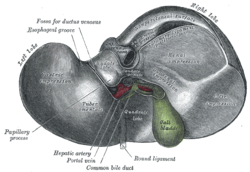Round ligament of liver
| Round ligament of liver | |
|---|---|
 Liver seen from below, with the round ligament labeled at bottom. | |
 1: Right lobe of liver 2: Left lobe of liver 3: Quadrate lobe of liver 4: Round ligament of liver 5: Falciform ligament 6: Caudate lobe of liver 7: Inferior vena cava 8: Common bile duct 9: Hepatic artery 10: Portal vein 11: Cystic duct 12: Hepatic duct 13: Gallbladder | |
| Details | |
| Precursor | left umbilical vein |
| Identifiers | |
| Latin | ligamentum teres hepatis |
| MeSH | D000069592 |
| TA98 | A05.8.01.015 |
| TA2 | 5104 |
| FMA | 14079 |
| Anatomical terminology | |
The round ligament of the liver (or ligamentum teres, or ligamentum teres hepatis) is the remnant of the umbilical vein that exists in the free edge of the falciform ligament of the liver. The round ligament divides the left part of the liver into medial and lateral sections.[1][2]
Since the round ligament is the remnant of the embryonic umbilical vein, it only exists in placental mammals. After the child is born, the umbilical vein degenerates to fibrous tissue, the round ligament.[3]
In adulthood, small paraumbilical veins remain in the substance of the ligament. These act as an important portacaval anastomosis in severe portal hypertension, resulting in a caput medusae.[4][5]
The umbilical vein/round ligament inserts around the umbilicus and is an important landmark of the inner surface of the anterior abdominal wall.[1]
Additional Images
-
Round ligament of liver.Superior surface of liver.
External links
- Anatomy photo:38:12-0106 at the SUNY Downstate Medical Center - "Stomach, Spleen and Liver: The Visceral Surface of the Liver"
- Anatomy image:7819 at the SUNY Downstate Medical Center
- Overview at ucc.edu
- Illustration of Liver Anatomy including ligaments and structures
References
- ^ a b Gray's anatomy : the anatomical basis of clinical practice. Standring, Susan (Forty-first ed.). [Philadelphia]. 2016. ISBN 9780702052309. OCLC 920806541.
{{cite book}}: CS1 maint: location missing publisher (link) CS1 maint: others (link) - ^ Moore, Keith L. (2013-02-13). Clinically oriented anatomy. Dalley, Arthur F., II,, Agur, A. M. R. (Seventh ed.). Philadelphia. ISBN 978-1451119459. OCLC 813301028.
{{cite book}}: CS1 maint: location missing publisher (link) - ^ Garbar, Veronica; Newton, Bruce W. (2020), "Anatomy, Abdomen and Pelvis, Falciform Ligament", StatPearls, StatPearls Publishing, PMID 30969680, retrieved 2019-09-28
- ^ Foster, R J; Cowell, G W (2015-04-20). "Acute paraumbilical vein recanalization: an unusual complication of acute pancreatitis". BJR Case Reports. 1 (1): 20150021. doi:10.1259/bjrcr.20150021. ISSN 2055-7159. PMC 6159162. PMID 30363191.
- ^ Mostbeck, G. H.; Wittich, G. R.; Herold, C.; Vergesslich, K. A.; Walter, R. M.; Frotz, S.; Sommer, G. (February 1989). "Hemodynamic significance of the paraumbilical vein in portal hypertension: assessment with duplex US". Radiology. 170 (2): 339–342. doi:10.1148/radiology.170.2.2643137. ISSN 0033-8419. PMID 2643137.

